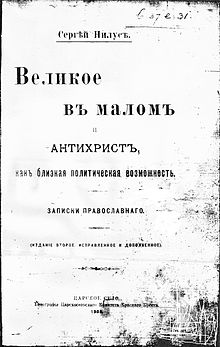The Protocols of the Elders of Zion
From Wikipedia, the free encyclopedia
"Protocols of Zion" redirects here. For the film, see Protocols of Zion (film).

Cover of first book edition, The Great within the Minuscule and Antichrist
| |
| Author | Unknown. Plagiarised fromHermann Goedsche andMaurice Joly, plagiarized in turn from Eugène Sue and Alexandre Dumas, père |
|---|---|
| Original title | Програма завоевания мира евреями (Programa zavoevaniya mira evreyami, "The Jewish Programme to Conquer the World") |
| Country | Russian Empire |
| Language | Russian, with plagiarism from German and French texts |
| Subject | Antisemitic conspiracy theory |
| Genre | Propaganda |
| Publisher | Znamya |
Publication date
| August–September 1903 |
Published in English
| 1919 |
| Media type | Fraudulent political treatise |
| Pages | 417 (1905 edition) |
| Part of a series on |
| Antisemitism |
|---|

Part of Jewish history
|
The Protocols of the Elders of Zion (Russian: Протоколы сионских мудрецов) or The Protocols of the Meetings of the Learned Elders of Zion is an antisemitic fabricated text purporting to describe a Jewish plan for global domination. The forgery was first published in Russia in 1903, translated into multiple languages, and disseminated internationally in the early part of the 20th century. According to the claims made by some of its publishers, the Protocols are the minutes of a late 19th-century meeting where Jewish leaders discussed their goal of global J

No comments:
Post a Comment